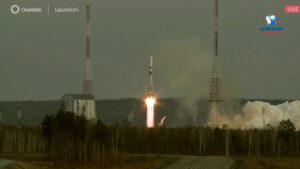OneWeb adds 36 satellites to broadband constellation as deployment accelerates
By Jason Rainbow

TAMPA, Fla. — OneWeb’s growing low Earth orbit broadband constellation is set to reach 182 satellites, after Arianespace launched its latest batch of 36 spacecraft April 25.
Arianespace launched the satellites with a Soyuz-2.1b rocket that blasted off 6:14 p.m. Eastern from the Vostochny Cosmodrome in Russia, putting them into a near-polar orbit at an altitude of 450 kilometers.
The satellites will raise themselves to operational orbit at an altitude of 1,200 kilometers, following nine separation sequences over a period of about four hours from lift-off.
One of the satellites from OneWeb’s previous batch of 36, which Arianespace launched March 25, allegedly could have come too close to a Starlink broadband spacecraft operated by SpaceX while making a similar journey.
OneWeb-0178’s course was adjusted after projected to come close to the Starlink-1546 satellite launched in September 2020, although the exact circumstances around the issue are unclear.
Arianespace’s latest launch for OneWeb pushes the broadband startup closer to an interim goal to expand coverage to north of 50 degrees latitude by June.
That coverage goal, which requires launching two more batches of 36 satellites, would enable OneWeb to provide services across the entire United Kingdom before the end of this year — an important milestone for a company recently sold to the British government and Indian telecom company Bharti Global.
It would also enable OneWeb to cover Alaska, Northern Europe, Greenland, Iceland, the Arctic Seas and Canada.
OneWeb ultimately plans a 650-strong constellation to deliver global high-speed, low-latency broadband services to enterprise, government, maritime and aviation customers from 2022.
Megaconstellation competition
SpaceX is estimated to have more than 1,300 Starlink satellites in low Earth orbit, as it launches them in batches of 60 for consumer broadband services currently in beta tests.
The U.S.-based company is asking for regulatory approval to expand its constellation as it reaches its limit at lower altitudes.
Under U.S. Federal Communications Commission rules, SpaceX can operate up to 1,548 satellites in orbits at altitudes around 550 kilometers.
It has regulatory approval for an additional 2,825 satellites at 1,100-1,300 kilometers, but requests permission to bring those down to 550 kilometers to improve latency.
Meanwhile, Amazon April 19 ordered nine Atlas 5 rockets from United Launch Alliance for its rival Project Kuiper broadband constellation in LEO.
The U.S. company did not disclose a time frame for these missions, although it must deploy half its 3,236-strong constellation by 2026 under its FCC license.
Canadian satellite fleet operator Telesat, which expects to start deploying its Lightspeed LEO constellation next year, has not yet finalized launch contracts.
Helping differentiate OneWeb’s constellation are plans to add some kind of navigational capability to its satellites, giving the British government a domestic capability following Brexit.
Neil Masterson, OneWeb’s CEO, said April 7 the company aims to have a demo capability available this year.
OneWeb launched an innovation challenge April 23 that is open to businesses as well as academic and research-based entities to help find technologies, products and solutions that advance space-based connectivity.
Proposals are due before May 17 and awards will be announced June 21.
Catherine Mealing-Jones, director of growth for the U.K. Space Agency, said: “As space offers increasingly diverse possibilities for scientific and commercial progress, this campaign is a great way to generate new ideas and invite more individuals and businesses to be a part of our growing industry.”
April 26, 2021 at 04:02AM
via SpaceNews read more...

Post a Comment